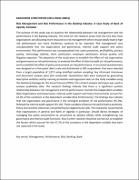| dc.description.abstract | KAKUHIKIRE CHRISTOPHER (2011-M102-20033)
Risk Management and Risk Performance in the Banking Industry: A Case Study of Bank of Uganda, Kampala
The purpose of this study was to examine the relationship between risk management and risk performance in the Banking Industry. The drive for the research arose from the fact that most organisations are allocating more resources to risk management which should ideally lead to high risk performance but more incidences continue to be reported. Risk management was conceptualised into risk organisation and governance, internal audit support and policy environment. Risk performance was conceptualised into asset protection, profitability, process quality, technology stability, client satisfaction, employee satisfaction, ethical quality, and litigation exposure. The objectives of the study were to establish the effect of risk organisation and governance on risk performance; to evaluate the effect of internal audit on risk performance; and to establish the effect of policy environment on risk performance. A structured questionnaire was designed on a five-point Likert scale and distributed to 285 respondents that were selected from a target population of 1,017 using stratified random sampling. Key informant interviews and document reviews were also conducted. Quantitative data were analysed by generating descriptive statistics and by running correlation and regression tests on the study variables using the Statistical Package for the Social Sciences (SPSS). The content analysis technique was used to analyse qualitative data. The research findings indicate that there is a significant positive relationship between risk management and risk performance. Overall, the independent variables (Risk Organisation and Governance, Internal audit Support and Policy Environment) account for 42.3% of the variations in the dependent variable (Risk Performance). The findings also indicate that risk organisation and governance is the strongest predictor of risk performance (55.2%), followed by internal audit support (23.1%). These variables influence risk performance positively. Policy environment influences risk performance negatively by 6.8%. The researcher recommends that organisations in general and Bank of Uganda in particular, should devise strategies of managing the policy environment to circumvent its adverse effects while strengthening risk governance and internal audit functions. Also, further research should be carried out to establish the factors which account for the 57.7% of the variations in the dependent variable that were not captured in the study.
Key words: Management, Performance, Risk, Banking, Bank | en_US |


